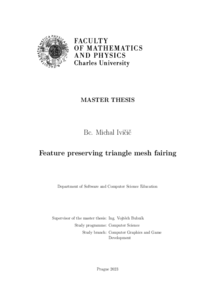Feature preserving triangle mesh fairing
Vyhlazování trojúhelníkových sítí se zachováním význačných rysů
diploma thesis (DEFENDED)

View/
Permanent link
http://hdl.handle.net/20.500.11956/184109Identifiers
Study Information System: 258120
Collections
- Kvalifikační práce [11363]
Author
Advisor
Referee
Rittig, Tobias
Faculty / Institute
Faculty of Mathematics and Physics
Discipline
Computer Science - Visual Computing and Game Development
Department
Department of Software and Computer Science Education
Date of defense
6. 9. 2023
Publisher
Univerzita Karlova, Matematicko-fyzikální fakultaLanguage
English
Grade
Excellent
Keywords (Czech)
diskrétní diferenciální geometrie|zpracování trojúhelníkových sítí|dělící povrchyKeywords (English)
discrete differential geometry|mesh processing|subdivision iiiV této práci řešíme problém hladkého interpolačního dělení trojúhelníkových sítí. Jedná se o obtížnější problém než obecné dělení trojúhelníkových sítí s vyhlazováním, protože původní vrcholy sítě nelze posouvat tak, aby výsledné povrchy byly jemnější. Na toto téma také není mnoho různých postupů v odpovídající literatuře. Jako řešení používáme minimalizaci globální vyhlazovací energie, která jako výsledek vrací pozice vrcholů nově přidaných do sítě. Tato metoda produkuje hladší výsledky než rozšířeně používané dělení zvané butterfly subdivision, ale za cenu vyšší výpočetní náročnosti a ztráty objemu výsledné sítě v některých případech. V práci analyzujeme, kde k takové ztrátě objemu dochází a implementujeme řešení, které ztrátě zabraňuje. Náš algoritmus navíc zachovává ostré hrany a body na povrchu sítě. Zatímco naše řešení dobře zvládá jednoduché objekty, v některých případech produkuje u složitějších objektů artefakty. Jako budoucí práce navrhujeme způsoby, jak náš algoritmus vylepšit, aby se potenciálně vyřešila většina takových artefaktů. 1
In this thesis, we address the problem of smooth interpolatory subdivision of triangle meshes. This problem is more challenging than general smooth subdivision as the original vertices of the mesh cannot be moved to produce smoother surfaces. There are also not that many existing works that cover this problem. As a solution, we use the minimization of a global fairness energy to compute the positions of newly added vertices of the mesh. This approach results in smoother surfaces than the widely used butterfly subdivision scheme, but at the cost of increased computational complexity and potential volume loss in the resulting mesh. We analyze the sources of volume loss and implement a solution to prevent it. Our algorithm also preserves sharp edges and points on the mesh surface. While our solution performs well for basic objects, it may produce artifacts for more complex ones. As a future work, we suggest ways to improve our algorithm to address the artifact occurrences. 1
